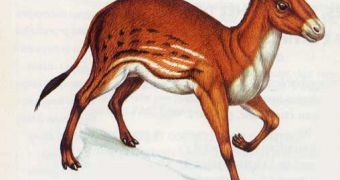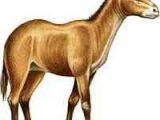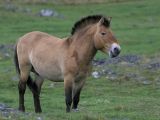Of all the domestic animals, the horses have been permanently associated with the progresses of human culture and civilization. It boosted human trade, migrations and conquests. The era of the technology let the role of the horse obsolete.
The horse was domesticated in the Asian steppes. Today, the genus Equus, comprising the horse, has 7 species: horse (E. caballus), donkey and African wild ass (E. asinus), onager or Asian wild ass (E. onager), kiang or Tibetan wild ass (E. kiang) and three species of African zebras.
The Przewalski horse (E caballus przewalskii) of Mongolia is the only surviving wild horse. All the other "wild" horses, called mustangs, are just escaped bewildered (feral) domestic horses. Even the tarpan and konig horses of Eastern Europe could have been just feral.
The oldest known horse ancestor was Hyracotherium ("Hyrax-like beast") (synonymous to Eohippus "early horse"), an animal the size of a fox. It did not have hooves, but its rear limbs had 3 digits, while the anterior limbs had 4 digits, announcing the odd-toed model of horses.
Today, many consider this animal to have been related to horses, not a direct ancestor. Hyracotherium lived throughout the forests of Asia, Europe, and North America during the Early to Mid Eocene, 60 to 45 Ma ago.
Mesohippus ("middle horse") lived some 40 Ma ago in the mid- Oligocene in North America. It was about the size of a German shepherd (2 ft or 60 cm tall) and, with its longer feet point, it was a good runner. The fourth digit of the fore limb was reduced.
The larger teeth and longer jaws show an adaptation for eating drier vegetation, but Mesohippus was still a browser, consuming tender vegetation and fruit. The brain was comparable to today's horse.
Merychippus ("ruminant horse"; still, the animal did not ruminate) lived 17 to 11 Ma ago during the Miocene. It still had three toes on each foot, but the middle toe was much larger than the lateral ones. This is the first horse to have grazed. It was 1.2 m (4 ft) tall, as much as a pony. The head resembled that of today's horses.
Plesippus, which lived 3.5 Ma ago in the Pliocene of North America, already was the size of the horse we know. 2.5 Ma ago Plesippus entered Eurasia via Bering Strait area.
2 Ma ago, Equus horses appeared from Plessipus. They had split from the ancestors of zebras and asses. The horses emerged in Eurasia and crossed into North America, where they disappeared 11,000 years ago. The modern horse species, Equus caballus, appeared 630,000 to 320,000 years ago.
The diet of the Paleolithic people living in Europe relied heavily on horse meat, and researchers even discovered, at Solutre (France), a 350 m (1,266 ft) tall cliff to which Europeans, 15,000 years ago, drove horse herds during the hunt, to make them fall, hunting the wounded animals easily. Horses are believed to have been domesticated 5,000 years ago, independently in Europe, Central Asia and Middle East.

 14 DAY TRIAL //
14 DAY TRIAL // 

